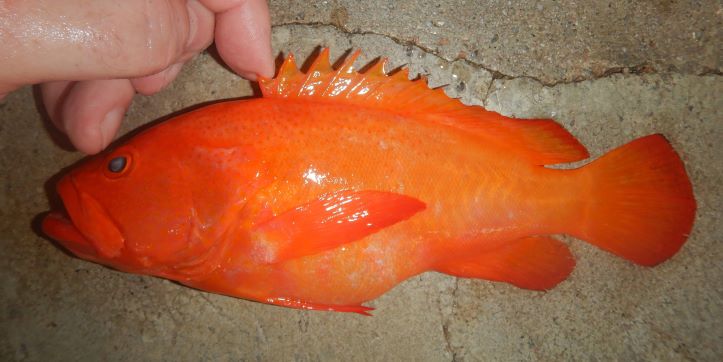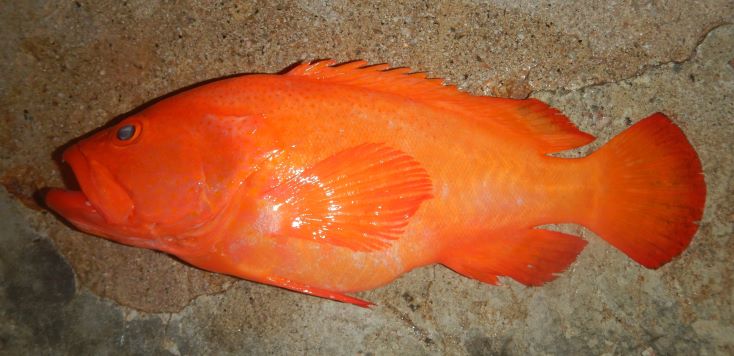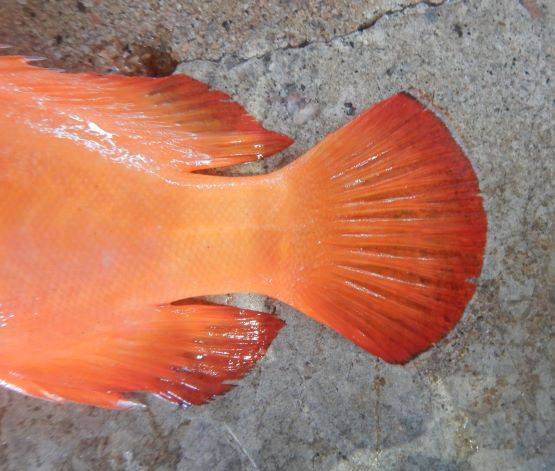Description:
Dorsal spines: 9; Dorsal rays: 14-16; Anal spines: 3; Anal rays: 8-9.
Relatively small, moderately slender grouper. Relatively short snout. Interorbital area flat. Maxilla scaly, reaching to or beyond vertical at rear edge
of eye. Preopercle rounded, finely serrate, the lower edge fleshy; subopercle and interopercle serrate. Pectoral fins distinctly longer than pelvic fins.
Pelvic fins reaching to or slightly before anus. Dorsal fin membranes distinctly incised between the spines. Caudal fin rounded.
Colour. Pale orange-red to orange-yellow or golden body, small red to yellow spots on the head, anterior body, and along the dorsal-fin base.
Posterior margin of caudal fin with a pale blue edge and black submarginal line; posterior parts of dorsal and anal fins often with a narrow pale
blue edge.
Size:
Maturity: Unknown. Max length : 30.0 cm TL.
Habitat and Ecology:
A poorly known, relatively rare, deep-water grouper (depth 40 - 300 m, usually 100 - 250 m). Found on steep seaward reefs.
Feeds mainly on crabs. Solitary.
Fishery Status:
This species is not protected or suibject to fishery regulations. It is a rare component of the catch due to its relative scarcity and typically deep depth of occurrence.
Notes:
Usually considered to be a young C. sonnerati by fishers and hence named "msye angar".
References:
Amorim, P. et al (2018). Cephalopholis aurantia. The IUCN Red List 2018: https://dx.doi.org/10.2305/IUCN.UK.2018-2.RLTS.T132725A100453919.en. (20/02/23).
Bray, D.J. (2017). Cephalopholis aurantia in Fishes of Australia, https://fishesofaustralia.net.au/home/species/5173 (21/02/23)
Craig, M.T. et al (2011). Groupers of the World - a field and market guide. NISC (Pty) Ltd, South Africa. ISBN: 978-1-920033-11-8
Froese, R. & D. Pauly. (Eds.) (2021). FishBase. Cephalopholis aurantia https://www.fishbase.se/summary/6443 (20/02/23).
Heemstra, P.C. & J.E. Randall, (1993). FAO Species Catalogue. Vol. 16. Groupers of the world (family Serranidae, subfamily Epinephelinae). An annotated
and illustrated catalogue of the grouper, rockcod, hind, coral grouper and lyretail species known to date. Rome: FAO. FAO Fish. Synop. 125(16):382 p.
Citation:
Nevill, J.E.G. (2023). Cephalopholis aurantia, Golden hind. Seychelles Seatizens. www.seatizens.sc. https://seatizens.sc/species/cephalopholis-aurantia-valenciennes-1828/




Really appreciate you sharing this blog.Thanks Again. Really Great.
I started fetching https://www.cornbreadhemp.com/collections/thc-drinks a teeny-weeny while ago just to see what the hype was about, and now I truly look forward to them preceding the time when bed. They don’t knock me abroad or anything, but they make a show it so much easier to numbing and fall asleep naturally. I’ve been waking up view pathway more rested and not sluggish at all. Even-handedly, nice of impose upon I’d tried them sooner.
Thanks again for the blog.Thanks Again.
Great article post. Fantastic.
Thanks again for the post. Really Great.
I appreciate you sharing this post. Will read on…
I think this is a real great blog article.Thanks Again. Awesome.
Great article.Thanks Again. Really Great.
Major thanks for the article.Much thanks again. Really Great.
Say, you got a nice blog. Cool.
This is one awesome blog.Really looking forward to read more. Really Cool.
I truly appreciate this article post.Really looking forward to read more. Want more.
I think this is a real great article.Really thank you! Awesome.
I loved your article post. Really Cool.
Major thankies for the post. Keep writing.
I really like and appreciate your article. Fantastic.
Fantastic article.Thanks Again. Cool.
Wow, great article.
Muchos Gracias for your post.Really looking forward to read more. Want more.
Awesome article post.Really looking forward to read more. Want more.
A round of applause for your article post.Much thanks again. Will read on…
Thank you for your blog post. Fantastic.
Looking forward to reading more. Great blog.Much thanks again. Awesome.
Thanks for the article. Cool.
Enjoyed every bit of your article.Thanks Again. Great.